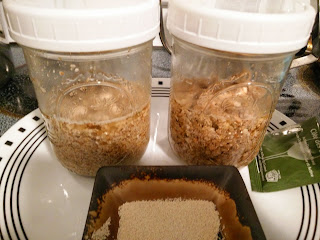Nuruk Comparison

Currently brewing is a comparison between two brands of nuruk: a "market" nuruk purchased stateside and an artisan nuruk produced in Busan. Initial notes on the nuruk itself: To review, nuruk is the fermentation starter used for makgeolli and other kinds of traditional Korean beverages. It consists of fermented grains or rice and is home to a diverse set of micro-organisms. The "market" nuruk was purchased at H-Mart in the US under the brand Haeoreum. It has a pungent earthy aroma that is somewhat tangy on the nose. I would definitely describe the smell as moldy, but not foul or rank. It does not smell like decomposition. You may even describe the smell as reminiscent of a cellar or attic, but remember: no two smell alike. It definitely has an older scent than the Busan nuruk. The Busan nuruk was acquired from a friend, and I don't think it is available to purchase in the US. The aroma is a combination of earthy and woody, but neutral. There is n...